Beef jerky has long been a favorite snack for its savory taste and convenient portability. However, questions like “does beef jerky need to be refrigerated?” or how to keep it fresh often leave snack enthusiasts puzzled. Proper storage is key to preserving its flavor and ensuring every bite is as satisfying as the first.
In this guide, we’ll dive into everything you need to know about beef jerky preservation. From understanding the role of preservatives and packaging to knowing when refrigeration is necessary, we’ll cover it all. Plus, you’ll discover practical tips to avoid spoilage and maximize your jerky’s shelf life.
For those craving the best in quality, Khô bò CALI offers an exceptional range of smoked beef jerky that’s sure to elevate your snack experience. Get ready to enjoy your jerky with confidence, knowing it’s stored just right!
Does Beef Jerky Need to Be Refrigerated? Here’s What You Need to Know
Beef jerky is a snack loved for its convenience and long shelf life, but the question, “does beef jerky need to be refrigerated?” often arises. The short answer is no—most beef jerky does not require refrigeration. However, there are certain cases where proper storage, including refrigeration, becomes essential to preserve its quality and freshness.
To understand when refrigeration is necessary, it’s important to consider the role of preservatives and packaging in extending jerky’s shelf life. Many store-bought jerky products come vacuum-sealed or packed using a method called Modified Atmosphere Packaging (MAP). In MAP, the air inside the package is replaced with a specific blend of gases designed to keep the product fresh for longer periods. These methods make unopened jerky shelf-stable for up to a year or until the best-by date on the package, making refrigeration unnecessary.
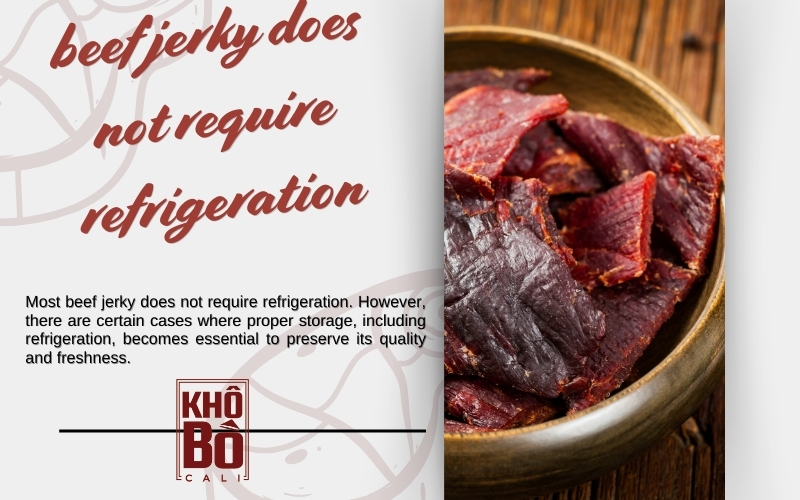
That said, once a package is opened, how you store your jerky depends on its type. Some high-moisture jerky may benefit from refrigeration to prevent spoilage, while drier, well-preserved varieties can remain fresh at room temperature if properly sealed.
In this guide, we’ll explore when refrigeration might be necessary, how to store your beef jerky for maximum freshness, and the key factors to consider when choosing your snack. Whether you’re wondering about the best storage practices or seeking to understand the science behind beef jerky preservation, we’ve got you covered.
Understanding the Shelf Stability of Beef Jerky
Beef jerky is renowned for its impressive shelf stability, making it a go-to snack for outdoor adventures, busy schedules, or simple pantry stocking. When stored properly, unopened jerky can last up to a year or until the best-by date indicated on the packaging. This extended shelf life is largely due to the dehydration process and packaging methods that prevent spoilage.
However, once you break the seal, the rules for storage change. Opened jerky is exposed to moisture and oxygen, which can compromise its freshness and quality over time. To ensure your jerky stays delicious and safe to eat, refrigeration becomes essential in many cases. Storing opened jerky in the fridge not only helps maintain its texture and flavor but also extends its usability for up to three days.

It’s important to note that not all jerky products are created equal. Some may have higher moisture content or fewer preservatives, requiring refrigeration even before opening. To avoid any confusion, always check the packaging—if refrigeration is necessary, it will be clearly stated on the bag or box.
By understanding these storage guidelines and taking the necessary precautions, you can enjoy every bite of your jerky at its peak quality, whether you’re snacking at home or on the go.
>> Readmore: How to Know When Beef Jerky Is Done: Unlocking the Perfect Texture and Flavor
Can Beef Jerky Actually Go Bad? Here’s What You Should Know
Yes, beef jerky can go bad, despite its reputation for being a long-lasting snack. While it’s designed to have a lengthy shelf life, improper storage or exceeding the recommended consumption period can lead to spoilage. Signs of bad jerky include a noticeable change in smell, such as an unpleasant or sour odor, and a darker, discolored appearance. If you observe any of these signs or even suspect the jerky may no longer be safe, it’s best to err on the side of caution—do not consume it.
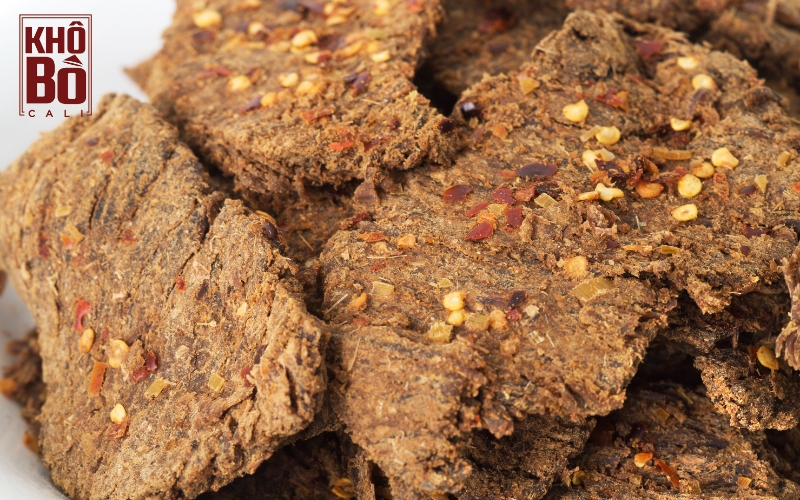
Manufacturers like LK take steps to ensure you know when your jerky is at its best. Each package includes a clearly printed “best by” date, indicating the timeframe during which the product is guaranteed to retain its optimal flavor, texture, and quality. While beef jerky is generally shelf-stable, its quality may decline after the best-by date, or more than three days after the package has been opened, especially if it hasn’t been stored properly.
To avoid disappointment or health risks, always adhere to the guidance provided on the packaging. If you’re uncertain or have concerns about the product, don’t hesitate to reach out to customer service for clarification. By being mindful of these factors, you can ensure that every bite of your beef jerky is both delicious and safe to enjoy.
Readmore: Guide to 3 simple ways on how to make dried beef for snacking during the Lunar New Year
The Role of Preservatives in Beef Jerky and Their Impact on Refrigeration Needs
Preservatives play a crucial role in the longevity of beef jerky, significantly reducing the need for refrigeration. These additives help keep jerky fresh by preventing the growth of harmful bacteria, mold, and yeast—organisms responsible for food spoilage. As a result, jerky can remain shelf-stable for extended periods without the need for cooling.
One of the most important preservatives in jerky is sodium nitrite. This compound not only preserves the vibrant color and rich flavor of the meat but also prevents the growth of botulism-causing bacteria, which can pose a serious health risk. Another commonly used preservative is sodium erythorbate, which aids in the curing process and prevents oxidation, ensuring the jerky maintains its freshness and texture.
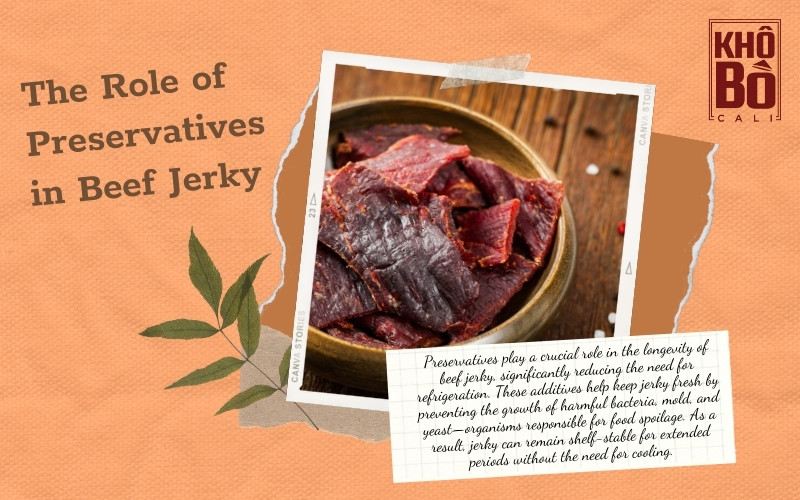
In addition to these synthetic preservatives, natural ingredients like salt, smoke, and vinegar contribute to jerky’s shelf stability. Salt, a powerful dehydrator, draws moisture out of the meat, creating an environment where bacteria struggle to thrive. The smoking process not only adds a distinct flavor but also acts as a natural preservative, adding an extra layer of defense against spoilage. Vinegar, with its natural acidity, further creates an inhospitable environment for bacteria, making it another key element in jerky preservation.
Thanks to these preservatives, unopened beef jerky can typically be stored at room temperature for several months. However, once the package is opened and the jerky is exposed to air, the preservatives’ effectiveness begins to diminish. This is where the question of “does beef jerky need to be refrigerated?” becomes relevant. Refrigeration can help maintain the jerky’s quality, slowing down any potential spoilage and ensuring it stays fresh for a longer period after opening.
The Impact of Packaging on Beef Jerky’s Freshness and Shelf Life
Just as preservatives are vital in extending the shelf life of beef jerky, the packaging plays an equally important role in protecting it from spoilage. Effective packaging creates a barrier that shields the jerky from external factors such as air, moisture, and contaminants, which could otherwise cause degradation.
Vacuum-sealing is one of the most common and effective packaging methods, as it removes excess air from the package. By reducing oxygen levels, vacuum-sealing significantly lowers the risk of spoilage, as oxygen is a key factor in the growth of bacteria and the process of oxidation. Additionally, some jerky brands go a step further by including an oxygen absorber packet, which actively removes any remaining oxygen inside the packaging, providing an extra layer of protection against the elements that contribute to spoilage.
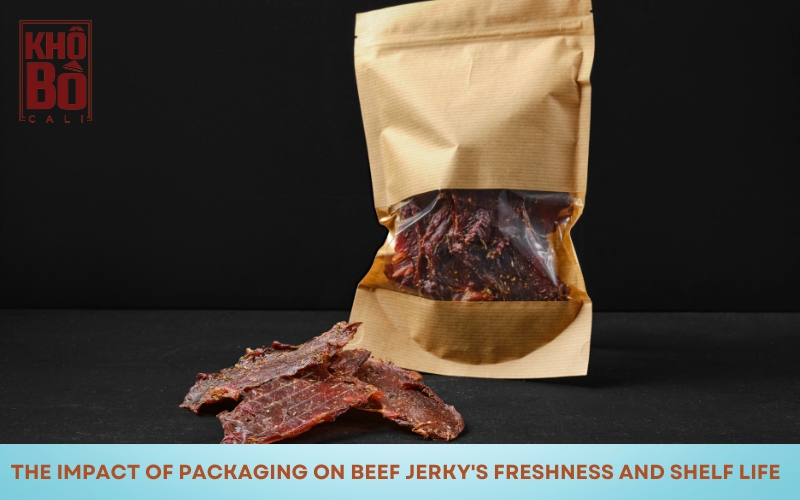
Another useful packaging innovation is resealable bags. These allow consumers to easily close the package after opening, helping to keep moisture, dust, and other contaminants out. This feature helps to preserve the jerky’s flavor and texture for longer periods, even after it’s been opened.
However, while the packaging is designed to preserve the jerky’s freshness, it is not foolproof. Once opened, the protective seal is compromised, and if the jerky isn’t consumed within a few days, it may start to lose its quality. In these cases, refrigeration can be a smart option to keep the jerky fresh and extend its shelf life. Now, let’s delve deeper into the situations where refrigerating beef jerky is necessary to ensure its optimal freshness.
When Should You Refrigerate Beef Jerky?
While beef jerky is generally shelf-stable and doesn’t require refrigeration, there are certain situations where chilling it can be beneficial. So, when should beef jerky be refrigerated?
There are two main scenarios where refrigeration makes sense: when the room temperature is too high or when you’re storing jerky in bulk for a long period.
First, high temperatures can significantly affect the quality of beef jerky. If stored in an environment where temperatures regularly exceed 80°F (27°C), the heat can promote bacterial growth and accelerate spoilage. This is especially a concern during hot summer months or in climates without air conditioning. In these cases, refrigeration serves as a protective measure, maintaining a cool, stable temperature that slows down the growth of bacteria and helps preserve the jerky’s flavor and texture.

Secondly, if you purchase or prepare beef jerky in large quantities, you may not be able to consume it all before its quality starts to degrade at room temperature. For long-term storage, refrigeration becomes essential to extend the shelf life of the jerky. By keeping it in the fridge, you create an environment where microbial growth is slowed, helping to preserve the jerky’s taste and texture for a longer period. To maximize the freshness, it’s important to store the jerky in sealed containers or bags to prevent moisture from affecting it.
In both of these cases, refrigeration is an effective way to protect your jerky and keep it as fresh and flavorful as possible. With these steps, you’ll ensure that your jerky remains in top condition, ready to be enjoyed whenever you choose. Now, the next question is: how long does beef jerky last in the refrigerator?
How Long Does Beef Jerky Last in the Refrigerator?
One of the key reasons people love beef jerky is its impressive shelf life, and when stored properly in the refrigerator, you can extend that lifespan even further. Refrigeration plays a crucial role in preserving the jerky’s freshness and quality.
Typically, beef jerky stored in the fridge can last anywhere from one to two months. This extended shelf life far surpasses what you can achieve with room-temperature storage. However, to make the most of this longevity, it’s important to keep the jerky sealed in an airtight container or a resealable bag. Proper sealing prevents exposure to moisture and air—two factors that can cause the jerky to spoil more quickly.
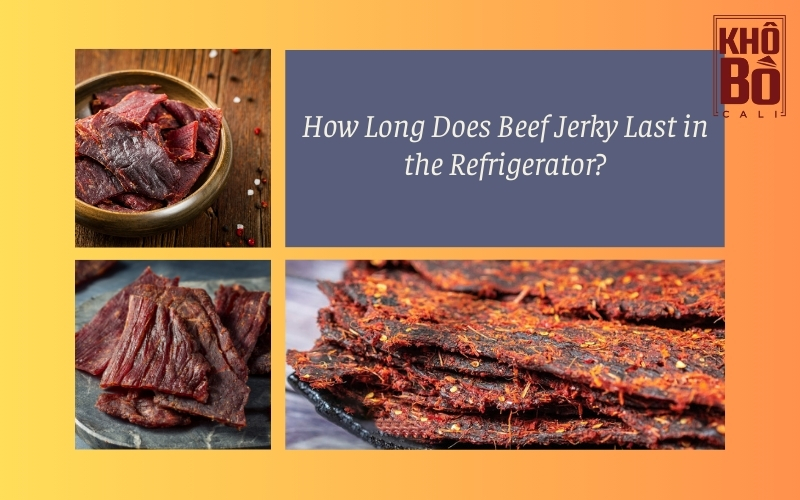
But what about at room temperature? An opened package of beef jerky, when kept at room temperature, will typically stay at its best quality for about one to two weeks. While the preservatives and the dehydration process used in jerky production help inhibit bacterial growth, the taste and texture begin to degrade after this time.
Refrigeration, however, slows this degradation process, helping to retain the jerky’s chewy texture and savory flavor for a longer period. That said, the actual shelf life can vary depending on factors like the type of jerky, the ingredients used, and the presence of additional preservatives. For instance, homemade beef jerky may not last as long in the fridge due to the absence of commercial preservatives.
Regardless of storage method, always check for signs of spoilage, such as unusual odors, color changes, or mold, before consuming jerky. Even if you’re asking “does beef jerky need to be refrigerated?” and have stored it properly, a quick inspection will ensure your jerky is still safe and tasty to enjoy.
How to Properly Refrigerate Beef Jerky
If you’ve decided to refrigerate beef jerky to extend its shelf life, you’re on the right track! Here’s a simple guide on how to store your jerky properly in the fridge to keep it fresh for as long as possible.
Start by inspecting the packaging of the beef jerky. If the original packaging is not resealable or has been compromised in any way, you’ll need to transfer the jerky to an airtight container or a heavy-duty resealable plastic bag. This is crucial for minimizing exposure to air and moisture, which are the main contributors to spoilage.
Before sealing the container or bag, try to remove as much air as possible. Excess air can cause oxidation and encourage moisture buildup, both of which lead to a loss of quality. If you have access to a vacuum sealer, it’s a great tool to use for this purpose. Vacuum sealing removes nearly all the air, ensuring your jerky is stored in the best possible conditions.

Make sure to label the container or bag with the date you first refrigerated the jerky. This simple step allows you to track how long it’s been stored, ensuring that you consume it while it’s still at its peak freshness. This is especially helpful if you’re storing multiple batches of jerky with varying dates.
Next, place the sealed jerky in the coldest part of your refrigerator. Avoid storing it in the door, as the temperature there fluctuates with every opening. For consistent cold storage, the back of the fridge is usually the best place to keep your jerky.
Lastly, it’s important to monitor your jerky for any signs of spoilage over time. While refrigeration greatly slows down the spoiling process, it doesn’t stop it entirely. Check for mold, off-smells, or any changes in texture, and discard the jerky if you notice any of these signs. With proper refrigeration, your jerky can remain fresh and delicious for an extended period, but always ensure it’s safe before enjoying it.
Can You Freeze Beef Jerky for Long-Term Storage?
Now that you’ve learned how to refrigerate beef jerky to maintain its freshness, you might be wondering if freezing jerky is an option when you need to store it for an extended period. The answer is yes — freezing beef jerky is a fantastic way to preserve its flavor and significantly extend its shelf life beyond what refrigeration can offer. When stored properly, frozen jerky can maintain its quality for several months, even up to a year. Here’s the best way to freeze your jerky:
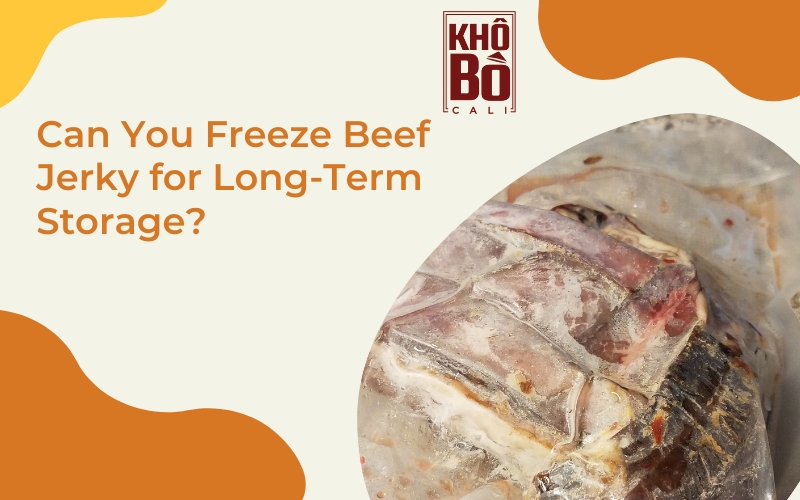
1. Preparation for Freezing
Before freezing, make sure your beef jerky has completely cooled to room temperature. If it’s homemade, this step is especially crucial, as it prevents condensation from forming inside the packaging. Condensation can lead to freezer burn, which would negatively impact the jerky’s texture and flavor.
2. Proper Packaging
To ensure your jerky remains protected, package it in airtight containers, heavy-duty freezer bags, or vacuum-sealed bags. Vacuum sealing is especially effective at removing excess air, which can cause freezer burn and affect the jerky’s overall quality. If you choose to use freezer bags, make sure to squeeze out as much air as possible before sealing them tightly.
3. Portioning for Convenience
Consider dividing your jerky into smaller portions that you can consume in one sitting. This will allow you to defrost only what you plan to eat, keeping the rest frozen and shielded from moisture and air, thus maintaining its quality.
4. Labeling
Label each package with the date you freeze it. This simple step helps you track how long your jerky has been stored, ensuring you use the oldest batches first to enjoy the jerky while it’s at its peak freshness.
5. Freezing
Place your packaged jerky in the coldest part of the freezer, away from the walls where temperature fluctuations are more likely to occur. This ensures that the jerky stays frozen at a consistent temperature, which is key to preserving its quality.
6. Thawing
When you’re ready to enjoy your jerky, take it out of the freezer and thaw it in the refrigerator for several hours or overnight. Thawing at a lower temperature reduces the risk of bacterial growth, keeping the jerky safe to eat.
7. Post-Thawing
Once your jerky is thawed, consume it within a few days for the best taste and texture. It’s essential not to refreeze jerky after it’s been thawed, as repeated freezing and thawing can degrade its flavor and texture.
Whether you decide to freeze or refrigerate beef jerky, it’s important to recognize the signs of spoilage. No matter how you store it, jerky will eventually need to be discarded if it’s not consumed within a reasonable timeframe. So, while you might be asking yourself “does beef jerky need to be refrigerated,” knowing how to properly freeze it can give you even more options for long-term storage without compromising its delicious taste and quality.
How to Spot Spoiled Beef Jerky
To ensure your beef jerky is safe to eat, it’s essential to watch for signs of spoilage. Consuming expired jerky can lead to health issues, so recognizing key visual and smell indicators is important.
Signs of Spoiled Jerky

Fresh jerky should have a consistent color and texture. Any mold growth (white, green, or black spots) or discoloration signals it’s no longer safe to consume. Also, if the jerky appears dull, it’s likely spoiled.
Next, smell the jerky. A fresh jerky will have a smoky, savory scent. Any sour, rancid, or off smells are clear indicators of spoilage.
Health Risks of Spoiled Jerky
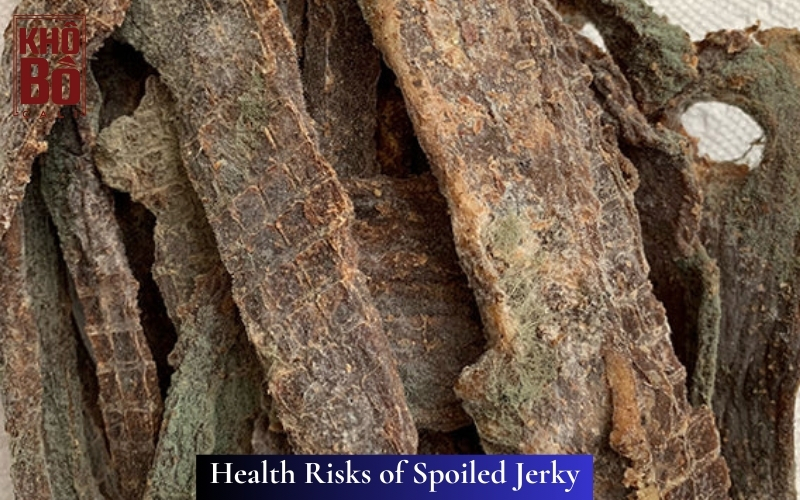
Eating spoiled jerky can expose you to harmful bacteria like Salmonella or E. coli, which can cause foodborne illnesses. Symptoms include nausea, vomiting, stomach cramps, and fever, with more severe risks for vulnerable groups, such as children, the elderly, or pregnant women.
By following proper storage methods, such as refrigerating jerky when necessary, you can reduce these risks and enjoy safe jerky.
Does Beef Jerky Need to Be Refrigerated?
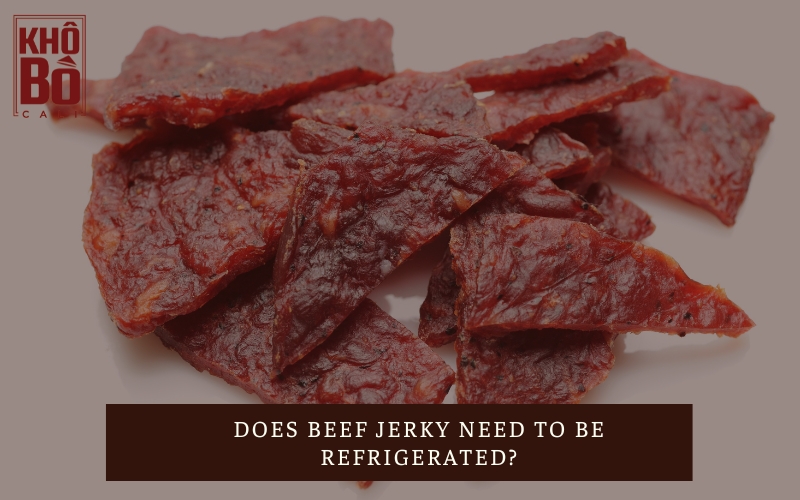
Jerky typically doesn’t require refrigeration unless stored in hot conditions or in bulk for extended periods. When refrigerated properly, jerky can last 1-2 months, preserving both taste and texture.
Always check for spoilage signs like off-odors or mold before consuming. If the jerky is questionable, it’s safest to discard it.
For more tips on dehydrating jerky or cooking methods, check out our other posts. But, if you’re after the best-tasting jerky, look no further than Khô Bò CALI for top-quality beef jerky and other exotic options!

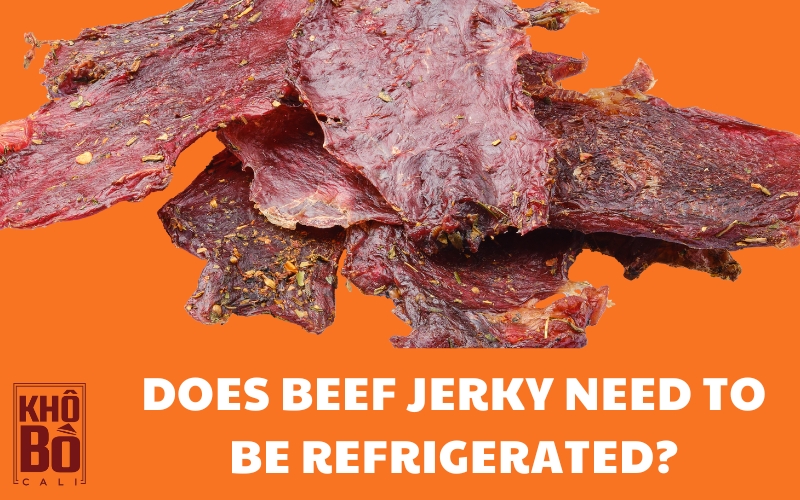

[…] >> Readmore: Does beef jerky need to be refrigerated? […]
[…] >> Readmore: Does beef jerky need to be refrigerated? […]